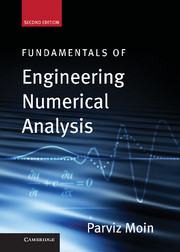Book contents
- Frontmatter
- Contents
- Dedication
- Preface to the Second Edition
- Preface to the First Edition
- 1 INTERPOLATION
- 2 NUMERICAL DIFFERENTIATION – FINITE DIFFERENCES
- 3 NUMERICAL INTEGRATION
- 4 NUMERICAL SOLUTION OF ORDINARY DIFFERENTIAL EQUATIONS
- 5 NUMERICAL SOLUTION OF PARTIAL DIFFERENTIAL EQUATIONS
- 6 DISCRETE TRANSFORM METHODS
- A A REVIEW OF LINEAR ALGEBRA
- Index
- References
2 - NUMERICAL DIFFERENTIATION – FINITE DIFFERENCES
Published online by Cambridge University Press: 05 June 2012
- Frontmatter
- Contents
- Dedication
- Preface to the Second Edition
- Preface to the First Edition
- 1 INTERPOLATION
- 2 NUMERICAL DIFFERENTIATION – FINITE DIFFERENCES
- 3 NUMERICAL INTEGRATION
- 4 NUMERICAL SOLUTION OF ORDINARY DIFFERENTIAL EQUATIONS
- 5 NUMERICAL SOLUTION OF PARTIAL DIFFERENTIAL EQUATIONS
- 6 DISCRETE TRANSFORM METHODS
- A A REVIEW OF LINEAR ALGEBRA
- Index
- References
Summary
In the next two chapters we develop a set of tools for discrete calculus. This chapter deals with the technique of finite differences for numerical differentiation of discrete data. We develop and discuss formulas for calculating the derivative of a smooth function, but only as defined on a discrete set of grid points x0, x1, …, xN. The data may already be tabulated or a table may have been generated from a complicated function or a process. We will focus on finite difference techniques for obtaining numerical values of the derivatives at the grid points. In Chapter 6 another more elaborate technique for numerical differentiation is introduced. Since we have learned from calculus how to differentiate any function, no matter how complicated, finite differences are seldom used for approximating the derivatives of explicit functions. This is in contrast to integration, where we frequently have to look up integrals in tables, and often solutions are not known. As will be seen in Chapters 4 and 5, the main application of finite differences is for obtaining numerical solution of differential equations.
Construction of Difference Formulas Using Taylor Series
Finite difference formulas can be easily derived from Taylor series expansions.
- Type
- Chapter
- Information
- Fundamentals of Engineering Numerical Analysis , pp. 13 - 29Publisher: Cambridge University PressPrint publication year: 2010



